Abstract
Present study deals with antioxidant potential of sequential extracts of fresh and dried rhizomes of Curcuma caesia, using solvents viz., hexane, petroleum ether, benzene, chloroform, ethyl acetate, methanol and water, which was analyzed by 2,2-diphenyl-1-picrylhydrazyl radical scavenging assay, total antioxidant capacity, ferric reducing activity and thiobarbituric acid reactive species assay. Total phenol content was estimated by the Folin-Ciocalteau method. C. caesia showed significant antioxidant activity in chloroform, benzene and ethyl acetate extracts. The chloroform extract was highly effective as free radical scavengers, electron-donating agents and reducing molybdate ions except for reducing lipid peroxidation. The highest total phenol content was also exhibited by chloroform and benzene extracts. Antioxidant potential expressed by C. caesia in the sequential extracts could be effectively utilized for identification of the bioactive compounds for future phytopharmacological applications.
Keywords: Curcuma caesia, antioxidants, reactive oxygen species, total phenols
Free radicals, which are molecules with unpaired electrons, play a key role in the development of various degenerative diseases, including aging, cancer, inflammation, diabetes, Alzheimer's disease and other neurodegenerative disorders[1,2]. They are formed as intermediates of various biochemical reactions, but when generated in excess can result in oxidative damage to DNA, proteins and lipids[3]. Free radicals containing oxygen, known as reactive oxygen species (ROS), are the most biologically significant free radicals. ROS include the superoxide and hydroxyl radical, plus derivatives of oxygen that do not contain unpaired electrons, such as hydrogen peroxide, singlet oxygen, and hypochlorous acid.
A class of compounds known as antioxidants control the formation of free radicals, by blocking the process of oxidation via scavenging these free radicals. Antioxidants are compounds that inhibit or delay oxidation of other molecules by terminating the initiation or propagation of oxidizing chain reactions. Restriction on the use of synthetic antioxidants due to their carcinogenic nature[4,5] has led to a growing interest in recent years in natural antioxidants of plant origin with low cytotoxicity for application in food industry to combat food deterioration. Natural antioxidants present in foods have attracted interest because of their safety, in addition to their nutritional and therapeutic effects. It is recognized that besides a role in endogenous defence of plants, human consumption of dietary antioxidants affords protection against some pathological events[6].
In recent years, synthetic antioxidants used as preservatives in processed foods, such as butylated hydroxyanisole (BHA) and butylated hydroxytoluene (BHT) are reported to be detrimental to human health and the search for plant-derived substances has intensified[7,8,9]. Thus, attention is now increasingly paid to the development and utilization of more effective and nontoxic antioxidants, of natural origin. Studies have shown that crude extracts or isolated pure compounds from a great number of natural medicinal plants were more effective antioxidants in vitro than BHT or vitamin E[10,11,12]. Epidemiological studies have also shown that the consumption of plant foods rich in antioxidants is beneficial to health as it protects against oxidative damage by inhibiting free radicals and reactive oxygen species[1,13,14]. Hence, medicinal plants can be a potential source of natural antioxidants.
Curcuma caesia Roxb., a member of the family Zingiberaceae and commonly known as black turmeric, is a perennial, erect rhizomatous herb with bluish-black rhizome of high economical importance because of its medicinal values (fig.1). It is native to North-East and Central India. Rhizomes of the plant are aromatic with intense camphoraceous odour and are applied externally to sprains and bruises[15]. The rhizomes are reported to contain antiinflammatory agents, and the paste of fresh rhizomes is used as a remedy for insect and snake bite by the Khamti tribe of Lohit district of eastern Arunachal Pradesh[16].
Fig 1.
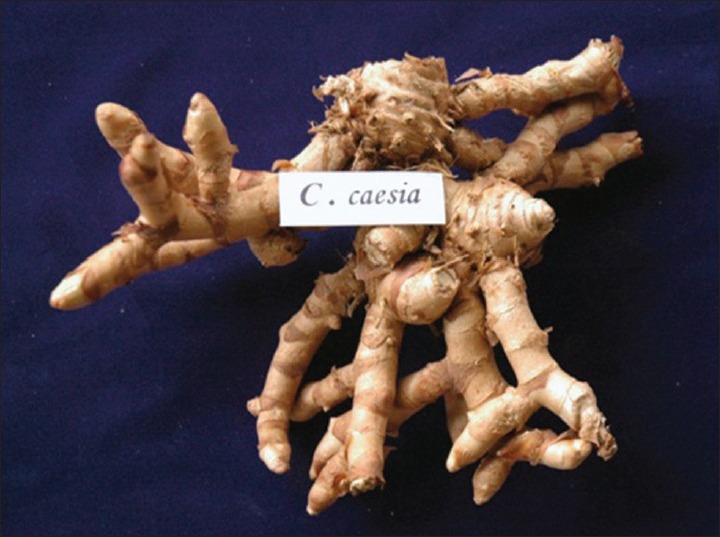
Fresh mature rhizomes of Curcuma caesia Roxb.
Much work has been conducted on the antioxidant activities of crude extracts of Curcuma caesia. Krishnaraj et al.[17] reported the antioxidant activity of C. caesia rhizome extract and found that it was significantly higher than C. amada rhizome extract. A study by Mangla et al.[18] showed that the methanol extract of C. caesia rhizomes had a moderate antioxidant activity as compared to the synthetic antioxidant, BHT. Both the enzymatic and crude extracts of the rhizomes and leaves of C. caesia have been analyzed by Dhal et al.[19] for their antioxidant activity in terms of DPPH and hydroxyl radical scavenging activity and revealed that the crude extracts (non enzymatic) are a better scavenger of free radical in comparison to enzymatic extracts in Curcuma species. Chirangini et al.[20] evaluated the antioxidant properties of crude methanol extracts of the rhizomes of eleven species of Zingiberales, including C. caesia using sulfur free radical reactivity with curcumin as the reference indicator and C. caesia possessed a good degree of antioxidant property. Sarangthem and Haokip[21] also compared the antioxidant activity of ethanol extract of C. caesia and C. longa. Indrajit et al.[22] studied the antioxidant activity of methanol extract of C. caesia on reactive oxygen species (ROS) and reactive nitrogen species (RNS) and it showed significant activity in a dose dependent manner. Oleoresins extracted using dichloromethane from rhizomes of nine starchy Curcuma species exhibited good antioxidant activity and C. caesia is one among them[23]. These studies were based on single solvent extraction either in fresh or dried rhizomes.
However, to ensure the complete extraction of wide polarity range of compounds, serial exhaustive extraction involving sequential extraction with solvents of increasing polarity is employed[24]. Most researchers use the Soxhlet apparatus for efficient extraction, but this is not suitable for extraction of thermo labile compounds as prolonged heating will lead to the degradation of these compounds[25]. Therefore, the present study was designed to evaluate the in vitro antioxidant activity of sequential extracts of fresh and dried rhizomes of C. caesia, macerated in solvents ranging from the least to maximum polarity, sequentially.
MATERIALS AND METHODS
Butylated hydroxyanisole (BHA), Butylated hydroxytoluene (BHT), 2,2-diphenyl-1-picrylhydrazyl (DPPH), thiobarbituric acid (TBA) and 2,2’-azobis-(2-amidinopropane) dihydrochloride (ABAP) were obtained from Sigma-Aldrich. All the other reagents and solvents were of analytical reagent grade and procured from Sisco Research Laboratories. Curcuma caesia rhizomes were obtained from the experimental farm of the Indian Institute of Spices Research at Peruvannamuzhi, Calicut. A portion of fresh rhizomes were washed, air dried and stored in freezer until the extraction, while the remaining rhizomes were cut into small pieces and sun dried for 48 h. Both fresh and dried rhizomes were subjected to extraction.
Preparation of plant extracts:
The fresh and dried forms of rhizomes of C. caesia (each 50 g) were sequentially extracted with 500 ml each of the following solvents, in the order: hexane, petroleum ether, benzene, chloroform, ethyl acetate, methanol and water. Each time before extracting with the next solvent, the rhizome material was dried at room temperature. The extracts were filtered with Whatmann filter paper no. 1 and evaporated to dryness using a rotary flash evaporator. Yield of the extract was recorded and extracts were stored at 4°, until analysis. The extracts were dissolved in methanol at a concentration of 0.01 g/ml prior to antioxidant assays. The antioxidant assays were also carried out on the synthetic antioxidants, BHA and BHT, at a concentration of 0.01% as a check.
DPPH radical scavenging assay:
The antioxidant activity of extracts was determined on the basis of the scavenging activity of the stable DPPH free radical by the method described by Braca et al.[26]. Aliquots of 50 μl of sample were made up to 5 ml with methanol and mixed with 1 ml of 0.004% DPPH in methanol and incubated in dark at room temperature for 30 min. A control was maintained with DPPH in methanol. The absorbance was measured at 517 nm against a blank in a Shimadzu UV-160A Spectrophotometer. The ability to scavenge the DPPH radical was calculated using the Eqn., scavenging activity (%)=(1-As/Ac)×100, where, As is the absorbance of sample; Ac is the absorbance of control. BHA and BHT were used as positive controls. Each extract was tested in triplicates and mean values calculated.
Total antioxidant capacity by phosphomolybdenum method:
The total antioxidant capacity was measured by spectrophotometric method of Prieto et al.[27]. An aliquot of 10 μl was made to 3 ml with methanol and mixed with 1 ml of reagent solution (0.6 M sulfuric acid, 28 mM sodium phosphate, and 4 mM ammonium molybdate). Blank consisted of 3 ml of methanol and 1 ml of reagent solution. The tubes were capped and incubated for 90 min at 95°. After the tubes had cooled to room temperature, absorbance was measured at 695 nm in a Shimadzu UV-160A Spectrophotometer. Total antioxidant activity was expressed as AAE (mmol ascorbic acid equivalent/g extract). BHA and BHT were used as positive controls. Each extract was tested in triplicates and mean values calculated.
Fe(III) to Fe(II) reducing activity:
The reducing power of the extracts was determined by the method of Oyaizu[28]. Aliquots of 20 μl of sample were made up to 1 ml with water and mixed with 2.5 ml of phosphate buffer (0.2 M, pH 6.6) and 2.5 ml of 1% aqueous potassium hexacyanoferrate, K3Fe(CN)6 solution. After 30 min incubation at 50°, 2.5 ml of 10% trichloroacetic acid was added, and the mixture was centrifuged for 10 min. A 2.5 ml aliquot of the upper layer was mixed with 2.5 ml of water and 0.5 ml of 0.1% aqueous FeCl3, and the absorbance recorded at 700 nm in a Shimadzu UV-160A Spectrophotometer. Ferric reducing activity was expressed as AAE (mmol ascorbic acid equivalent/g extract). BHA and BHT were used as positive controls. Each extract was tested in triplicates and mean values calculated.
Thiobarbituric acid reactive species assay:
A modified TBARS assay, using egg yolk homogenate as lipid rich media, was used to measure the antioxidant ability of the samples. Yolk homogenate was prepared as described by Dorman et al.[29], where an aliquot of yolk was used at a concentration of 10% w/v in KCl (1.15% w/v). The yolk was then homogenized for 30 s, followed by ultrasonication for a further 5 min. For TBARS assay, 500 μl of 10% w/v yolk homogenate and 50 μl of sample solubilised in methanol, were added to a test tube and made up to 1 ml with distilled water, followed by the addition of 50 μl of 2,2’-azobis-(2-amidinopropane) dihydrochloride (ABAP, 0.07 M) to induce lipid peroxidation. Further, 1.5 ml of 20% acetic acid (pH 3.5) and 1.5 ml of 0.8% (w/v) TBA in 1.1% (w/v) sodium dodecyl sulphate (SDS) were added. The tubes were stirred in a vortex, and heated to 95° for 60 min. After cooling to room temperature, 5 ml butan-1-ol was added to each tube, stirred and centrifuged at 3000 rpm for 10 min. The absorbance of the supernatant was measured at 532 nm in a Shimadzu UV-160A Spectrophotometer. All the values were expressed as antioxidant index (AI %). The AI % was calculated using, AI %=(1-As/Ac)×100, where Ac being the absorbance of the control and As, the absorbance of the test sample. BHA and BHT were used as positive controls. Each extract was tested in triplicates and mean values calculated.
Total phenol content:
Total phenol content was estimated according to the Folin-Ciocalteau method[30]. To the sample (20 μl), was added 250 μl of undiluted Folin-Ciocalteau reagent. After 1 min, 750 μl of 20% w/v aqueous sodium carbonate was added, and the volume made up to 5 ml with water. After 1 min of incubation at 100°, the absorbance was measured at 760 nm against a blank in a Shimadzu UV-160A Spectrophotometer. The results were expressed as GAE (mg gallic acid equivalent/g extract). Each extract was tested in triplicates and mean values calculated.
Statistical analysis:
Data are expressed as mean±standard deviation (SD) and subjected to one-way analysis of variance (ANOVA). Duncan's multiple range test (P≤0.05) was used to bring out the significant difference among fresh and dried rhizomes of C. caesia using SAS 9.3. In addition, student's t-test (P≤0.05) was performed to compare the significant difference between fresh and dried rhizomes.
RESULTS AND DISCUSSION
In the present work, in vitro antioxidant potential of sequential extracts of fresh and dried rhizomes of C. caesia with solvents of differing polarity was analyzed using protocols viz. DPPH radical scavenging assay, total antioxidant capacity, ferric reducing activity and TBARS assay. The results were compared using synthetic antioxidants viz. BHA and BHT, at a concentration of 0.01%, the concentration at which these are normally used for foods. Total phenol content was also ascertained in the extracts.
Table 1 gives the percentage yield during the sequential extraction of the rhizomes of C. caesia (fresh and dried). The rhizomes were sequentially extracted with different solvents of increasing polarity. Extracts obtained were viscous in nature and brown to brownish yellow in color. In the case of fresh rhizomes, yield ranged from 1 to 40 mg/g, maximum yield being shown in the water extract. In dried rhizomes, hexane, methanol and water showed higher yield. The purpose of employing sequential extraction with the same powder was to ensure the complete extraction of wide polarity range of compounds. Each extract was analyzed for antioxidant property.
TABLE 1.
YIELD OF SEQUENTIAL EXTRACTION OF C. CAESIA RHIZOMES WITH DIFFERENT SOLVENTS
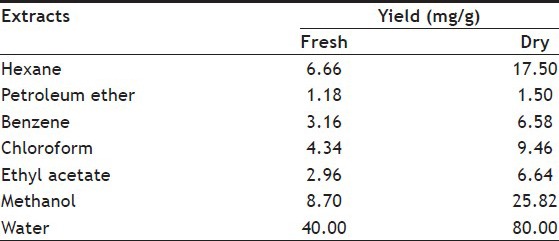
DPPH radical scavenging activities of the extracts from fresh and dried rhizomes of C. caesia are presented in Table 2. In fresh rhizomes, both chloroform and methanol extracts showed higher levels of scavenging activity, with 67.76 and 67.36%, while lowest activity was expressed in hexane extract (23.43%). In dried rhizomes, scavenging activity was high starting from the non polar solvent benzene (85.79%) to more polar solvents, viz. chloroform (92.98%), ethyl acetate (91.48%) and methanol (73.07%), maximum activity being expressed in chloroform extract. In both cases, hexane, petroleum ether and water extracts showed lesser scavenging activity ranging from 23.43 to 36.18%.
TABLE 2.
SCAVENGING ACTIVITY (%) OF SEQUENTIAL EXTRACTS OF C. CAESIA RHIZOMES USING DPPH RADICAL
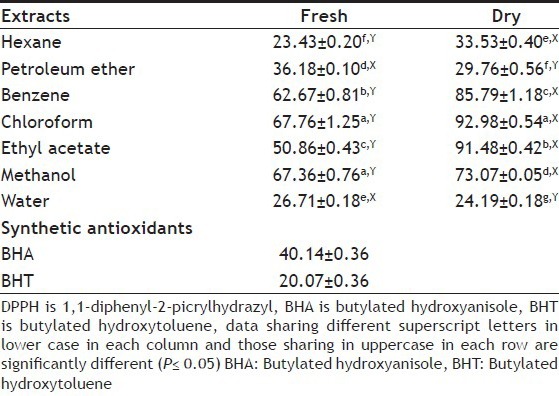
The phosphomolybdenum method is based on the reduction of molybdenum(VI) to molybdenum(V) by the antioxidants and the subsequent formation of a green phosphate/Mo(V) complex at acidic pH[27]. Table 3 illustrates the total antioxidant activities of successive extracts of C. caesia rhizomes as compared with the standard antioxidants, BHA and BHT. Chloroform extract showed the highest total antioxidant activity in both fresh and dried rhizomes, i.e. 2457.33 and 4534.33 mmol AAE/g extract, respectively, as compared to the other extracts. A higher level of antioxidant activity was shown in benzene and hexane extracts in fresh rhizomes (2327.67 and 2311.33 AAE ascorbic acid/g extract, respectively), while benzene and ethyl acetate extracts also expressed higher antioxidant property in dried rhizomes (4338.67 and 4024.67 mmol AAE/g extract, respectively). Interestingly, aqueous extracts of fresh and dried rhizomes had minimal reducing capacity.
TABLE 3.
TOTAL ANTIOXIDANT CAPACITY OF SEQUENTIAL EXTRACTS OF C. CAESIA RHIZOMES
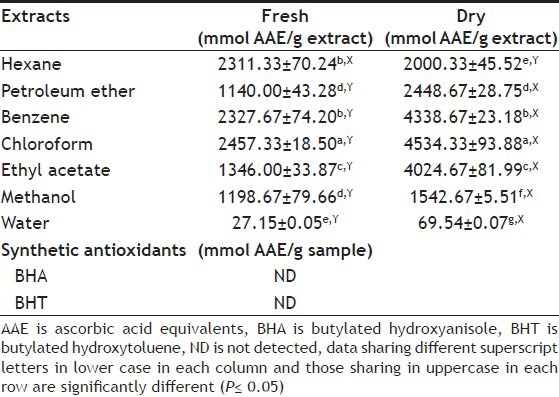
Ferric reducing assay is simple and effective for analyzing the antioxidants. Substances which have reduction potential react with potassium ferricyanide (Fe3+) to form potassium ferrocyanides (Fe2+), which then react with ferric chloride to form ferric-ferrous complex that has an absorption maxima at 700 nm[28]. Ferric reducing activity is expressed as mmol AAE/g extract (Table 4). The values ranged from 1084.33 to 1428.00 mmol AAE/g extract. However, among the extracts, solvents with lowest and highest polarity (hexane and water) could exhibit lower ferric reducing power in fresh rhizomes.
TABLE 4.
FERRIC REDUCING ACTIVITY OF SEQUENTIAL EXTRACTS OF C. CAESIA RHIZOMES
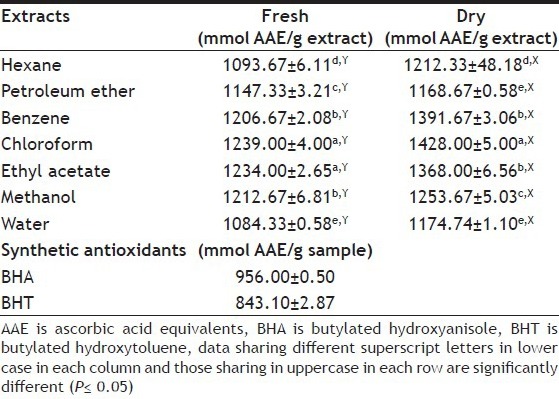
In this modified TBARS assay, egg yolk homogenate was used as lipid rich media. At the end of the incubation, the concentration of thiobarbituric acid-reactive substances (TBARS) was measured as the index of lipid peroxidation. Table 5 gives the level of lipid peroxidation in terms of TBARS produced in the rhizome extracts. Evidently, all the successive extracts with ascending polarity gave TBARS activity with narrow difference, ranging from 35.73 to 60.51 AI % in both fresh and dried rhizomes.
TABLE 5.
ANTIOXIDANT INDEX (%) OF SEQUENTIAL EXTRACTS OF C. CAESIA RHIZOMES USING TBARS ASSAY

Table 6 gives the total phenol content of fresh and dried rhizomes in the various extracts of C. caesia. Chloroform could extract the maximum levels of total phenols recording highest concentration of 57.53 mg GAE/g extract in fresh and 109.41 mg GAE/g extract in dried rhizomes. Benzene extracts was also found to have higher content of phenols with 56.64 mg GAE/g extract in fresh and 96.68 mg GAE/g extract in dried rhizomes. The lowest phenol content of 32.58 and 28.33 mg GAE/g extract was found in the methanol extract of fresh and dried rhizomes, respectively.
TABLE 6.
TOTAL PHENOL CONTENT IN SEQUENTIAL EXTRACTS OF C. CAESIA RHIZOMES
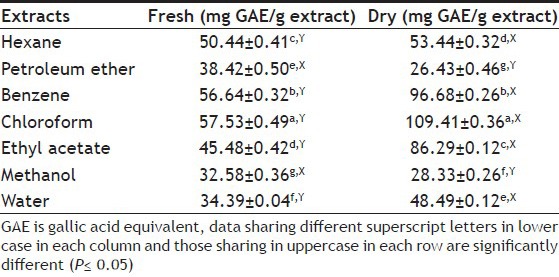
Only a few spices have been relatively extensively studied in terms of possible health effects, which mainly include various Zingiberaceae species. Curcuma plants contain many bioactive compounds such as phenols, flavonoids and antioxidant enzymes. Evaluation of antioxidant potential in plants could result in the identification of natural antioxidants with pharmacological value. These natural antioxidants can be substituted to synthetic antioxidants in food additives[19]. Therefore, the present work was focused to analyze the antioxidant potential of the non-conventional species of Curcuma, C. Caesia Roxb.
DPPH is a stable free radical with purple color. The antioxidants scavenge DPPH radicals by either the process of hydrogen- or electron-donation leading to a non-radical with yellow color. Substances capable of performing this reaction are considered to be antioxidants and therefore radical scavengers[31]. It is very convenient to follow the DPPH reactions and it has often been used to estimate the antiradical activity of the natural products. Hydrogen-donating ability of the antioxidant molecule contributes to its free radical scavenging nature[32]. Free radical scavenging is the generally accepted mechanism for how antioxidants inhibit lipid oxidation. In our study, maximum scavenging activity was found in the chloroform extracts of both dried and fresh rhizomes. The results concluded that higher antioxidant activity is present in samples extracted with more polar solvents.
The phosphomolybdate method has been used routinely to evaluate the total antioxidant capacity of plant extracts. In the presence of extracts, Mo(VI) is reduced to Mo(V) and forms a green coloured phosphomolybdenum complex, which shows a maximum absorbance at 695 nm. Here we observe almost similar trend for the total antioxidant activity with that of the DPPH method, where the chloroform extracts possessed the maximum antioxidant potential. Regarding the ferric reducing power, all the solvents used for the sequential extraction could extract more or less the same content of antioxidants in terms of ascorbic acid. In contrast the weakest ability to reduce the ferric ion was exhibited by hexane extract.
Peroxidation is important in food deterioration and in the oxidative modification of biological molecules particularly lipids[33]. Inhibition of lipid peroxidation by any compound is often used to evaluate its antioxidant potential. TBARS is a preferable method in order to study the potential of a compound as antioxidant in in vitro conditions similar to the real-life situation[34]. In the present study, all the solvents used sequentially could exhibit almost equal capacity of lipid peroxidation levels.
Phenolic compounds from plants are a rich source of natural antioxidants and the antioxidant property is mainly due to their redox properties. They act as reducing agents, hydrogen donors, singlet oxygen quenchers and metal chelators[35]. The active hydrogen-donating ability of the hydroxyl substitutions in the phenolic compounds makes them better scavengers of free radicals[36].
From the data presented above, it is evident that phenolic constituents are present at highest level in chloroform extract. But in addition to chloroform extract, methanol extract also showed highest radical scavenging activity. This may be explained on the basis of a possible synergism between phenolic compounds and other phytochemical compounds released in the methanol extract. A similar positive correlation of total polyphenols with antioxidant activity was also reported by Asadi et al. in Salvia species[37]. In addition, a linear correlation between total phenolic content and their antioxidant capacity have been demonstrated in different plant groups by several workers[38,39,40,41,42,43], while others show poor linear correlation or report total antioxidant activity and phenolic content with no comment[44,45]. However, the results obtained in our study reveal a direct relationship between total phenols and antioxidant potential.
Flavonoids, referred as aglycones in plants, are extracted with solvents based on their polarity. Less polar aglycones such as isoflavones, flavanones dihydroflavonols, higly methylated flavones and flavonols can be extracted with chloroform, ether, ethyl acetate[46,47]. The higher levels of total phenols in chloroform extract as observed in the present study may be due to the presence of flavonoids. It is important to note that the solvents such as alcohols (methanol and ethanol), acetone, ethyl acetate, often with different proportions of water, have been used for the extraction of phenolic compounds from plant materials. In particular, methanol and ethanol have been generally found to be more efficient in extraction of phenolic compounds. For instance, an investigation into the effect of different solvents on extraction of phenolics from the mango ginger showed that methanol was more efficient than other solvents used in the study[48]. Krishnaraj et al.[17] determined phenol content and antioxidant activity of C. caesia in comparison with Curcuma amada. The total phenol contents of the methanol rhizome extracts of C. amada and C. caesia were 37.64 mg and 44.33 mg tannic acid equivalents/g dry material, respectively. Polyphenols found in plant extracts are considered as the major bioactive compounds with antioxidant activity. Since the chemical structures of phenolic compounds determine their properties, identification of the nature of the phenolic compounds in the C. caesia is essential for further evaluation.
The study demonstrates the presence of potent antioxidant activity C. caesia extracts, probably derived from compounds such as flavonoids, phenols and sterols. Solvents with different polarity had significant effects on total phenolic contents, extracted components, and antioxidant activities. Because the specificity and sensitivity are different for each used method, it can be concluded that the same antioxidant samples exhibit different antioxidative values depending on the concentration and the measured antioxidant parameter. The information is of interest to the pharmaceutical industries since the rhizomes are a rich source of antioxidants. This primary information will help in conducting further studies on identification of bioactive constituents, determination of their efficacy by in vivo studies and demonstration of their safety and effectiveness in clinical trials.
ACKNOWLEDGEMENTS
The authors would like to thank KSCSTE for the fellowship awarded to the first author and Director, Indian Institute of Spices Research for providing laboratory facilities. We are also thankful to the Head and members of division of Crop Production and PHT for their support.
Footnotes
Reenu, et al.: Antioxidant potential of C. caesia
REFERENCES
- 1.Ames BN, Shigenaga MK, Hagen TM. Oxidants, antioxidants and the degenerative diseases of aging. Proc Natl Acad Sci USA. 1993;90:7915–22. doi: 10.1073/pnas.90.17.7915. [DOI] [PMC free article] [PubMed] [Google Scholar]
- 2.Halliwell B. Free radicals, antioxidants, and human disease: Curiosity, cause, or consequence? Lancet. 1994;344:721–4. doi: 10.1016/s0140-6736(94)92211-x. [DOI] [PubMed] [Google Scholar]
- 3.Halliwell B. Chichester (UK): John Wiley and Sons Ltd; 2005. Free Radicals and other reactive species in disease. [Google Scholar]
- 4.Lindenschmidt RC, Trika AF, Guard ME, Witschi HP. The effect of dietary butylated hydroxy toluene on liver and colon tumor development in mice. Toxicology. 1986;38:151–60. doi: 10.1016/0300-483x(86)90116-2. [DOI] [PubMed] [Google Scholar]
- 5.Kahl R, Kappus H. Toxicology of the synthetic antioxidants BHA and BHT in comparison with the natural antioxidant vitamin E. Z Lebensm Unters Forsch. 1993;196:329–38. doi: 10.1007/BF01197931. [DOI] [PubMed] [Google Scholar]
- 6.Suja KP, Jayalekshmy A, Arumugham C. Free radical scavenging behavior of antioxidant compounds of sesame (Sesamum indicum L.) in DPPH system. J Agric Food Chem. 2004;52:912–5. doi: 10.1021/jf0303621. [DOI] [PubMed] [Google Scholar]
- 7.Lobo V, Patil A, Phatak A, Chandra N. Free radicals, antioxidants and functional foods: Impact on human health. Pharmacog Rev. 2010;4:118–26. doi: 10.4103/0973-7847.70902. [DOI] [PMC free article] [PubMed] [Google Scholar]
- 8.Grice HC. Safety evaluation of butylated hydroxytoluene (BHT) in the liver, lung and gastrointestinal tract. Food Chem Toxicol. 1986;24:1127–30. doi: 10.1016/0278-6915(86)90298-x. [DOI] [PubMed] [Google Scholar]
- 9.Wichi HP. Enhanced tumor development by butylated hydroxyanisole (BHA) from the perspective of effect on forestomach and oesophageal squamous epithelium. Food Chem Toxicol. 1988;26:717–23. doi: 10.1016/0278-6915(88)90072-5. [DOI] [PubMed] [Google Scholar]
- 10.Gordon MH, Weng XC. Antioxidant properties of extracts from tanshen (Salvia miltiorrhiza Bunge) Food Chem. 1992;44:119–22. [Google Scholar]
- 11.Gu LW, Weng XC. Antioxidant activity and components of Salvia plebeian R. Br.–a Chinese herb. Food Chem. 2001;73:299–305. [Google Scholar]
- 12.Pyo YH, Lee TC, Logendrac L, Rosen RT. Antioxidant activity and phenolic compounds of Swiss chard (Beta vulgaris subspecies cycla) extracts. Food Chem. 2004;85:19–26. [Google Scholar]
- 13.Temple NJ. Antioxidants and disease: More questions than answers. Nutr Res. 2000;20:449–59. [Google Scholar]
- 14.Chatti IB, Boubaker J, Skandrani I, Bhouri W, Ghedira K, Chekir Ghedira L. Antioxidant and antigenotoxic activities in Acacia salicina extracts and its protective role against DNA strand scission induced by hydroxyl radical. Food Chem Toxicol. 2011;49:1753–8. doi: 10.1016/j.fct.2011.04.022. [DOI] [PubMed] [Google Scholar]
- 15.Vol. 2. New Delhi: CSIR; 2001. The Wealth of India. A dictionary of Indian raw materials and industrial products, First Supplement Series (Raw Materials) pp. 259–95. [Google Scholar]
- 16.Tag H, Das AK, Loyi H. Antiinflammatory plants used by the Khamti tribe of Lohit district in eastern Arunachal Pradesh, India. Nat Prod Rad. 2007;6:334–40. [Google Scholar]
- 17.Krishnaraj M, Manibhushanrao K, Mathivanan N. A comparative study of phenol content and antioxidant activity between nonconventional Curcuma caesia Roxb. and Curcuma amada Roxb. Int J Plant Prod. 2010;4:169–74. [Google Scholar]
- 18.Mangla M, Mohd S, Jain J, Kashyap M. In vitro evaluation of antioxidant activity of Curcuma caesia Roxb. Int J Pharm Sci Res. 2010;1:98–102. [Google Scholar]
- 19.Dhal Y, Bandita D, Sahu RK. Comparative antioxidant activity of non-enzymatic and enzymatic extracts of Curcuma zedoaria, Curcuma angustifolia and Curcuma caesia. Int J Plant Anim Environ Sci. 2012;2:232–9. [Google Scholar]
- 20.Chirangini P, Sharma GJ, Sinha SK. Sulfur free radical reactivity with curcumin as reference for evaluating antioxidant properties of medicinal Zingiberales. J Environ Pathol Toxicol Oncol. 2004;23:227–36. doi: 10.1615/jenvpathtoxoncol.v23.i3.60. [DOI] [PubMed] [Google Scholar]
- 21.Sarangthem K, Haokip MJ. Antioxidant activities, phenols and flavonoid contents of Curcuma Longa L. and Curcuma Caesia Roxb. found in Manipur. Bioscan. 2012;7:91–3. [Google Scholar]
- 22.Indrajit K, Narayan D, Pathik S, Nilanjan S, Asis B, Pallab KH. Scavenging activity of Curcuma caesia rhizome against reactive oxygen and nitrogen species. Orient Pharm Exp Med. 2011;11:221–8. [Google Scholar]
- 23.Angel GR, Vimala B, Bala N. Antioxidant and antibacterial activities of oleoresins isolated from nine Curcuma species. Phytopharmacology. 2012;2:312–7. [Google Scholar]
- 24.Green RJ. Masters Thesis. USA: North Carolina State University; 2004. Antioxidant activity of peanut plant tissues. [Google Scholar]
- 25.de Paira SR, Lima LA, Figueiredo MR, Kaplan MA. Plumbagin quantification in roots of Plumbago scandens L. obtained by different extraction techniques. Ann Acad Bras Cienc. 2004;76:499–504. doi: 10.1590/s0001-37652004000300004. [DOI] [PubMed] [Google Scholar]
- 26.Braca A, Tommasi ND, Bari LD, Pizza C, Politi M, Morelli I. Antioxidant principles from Bauhinia tarapotensis. J Nat Prod. 2001;64:892–5. doi: 10.1021/np0100845. [DOI] [PubMed] [Google Scholar]
- 27.Prieto P, Pineda M, Aguilar M. Spectrophotometric quantitation of antioxidant capacity through the formation of a phosphomolybdenum complex: Specific application to the determination of vitamin E. Anal Biochem. 1999;269:337–41. doi: 10.1006/abio.1999.4019. [DOI] [PubMed] [Google Scholar]
- 28.Oyaizu M. Studies on products of browning reaction: Antioxidative activity of products of browning reaction. Jpn J Nutr. 1986;40:307–15. [Google Scholar]
- 29.Dorman HJD, Deans SG, Noble RC, Surai P. Evaluation in vitro of plant essential oils as natural antioxidants. J Essent Oil Res. 1995;7:645–51. [Google Scholar]
- 30.Singleton VL, Orthofer R, Lamuela-Raventos RM. Analysis of total phenols and other oxidation substrates and antioxidants by means of Folin-Ciocalteu reagent. Methods Enzymol. 1999;299:152–78. [Google Scholar]
- 31.Brand-Williams W, Cuvelier ME, Berset C. Use of free radical method to evaluate antioxidant activity. Lebensm Wiss Technol. 1995;28:25–30. [Google Scholar]
- 32.Chen JH, Ho CT. Antioxidant activities of caffeic acid and its related hydroxycinnamic acid compounds. J Agric Food Chem. 1997;45:2374–8. [Google Scholar]
- 33.Rael LT, Thomas GW, Craun ML, Curtis CG, Bar-Or R, Bar-Or D. Lipid peroxidation and the thiobarbituric acid assay: Standardization of the assay when using saturated and unsaturated fatty acids. J Biochem Mol Biol. 2004;37:749–52. doi: 10.5483/bmbrep.2004.37.6.749. [DOI] [PubMed] [Google Scholar]
- 34.Maestri DM, Nepote V, Lamarque AL, Zygadlo JA. Natural products as antioxidants. In: Filippo I, editor. Phytochemistry: Advances in Research. Trivandrum: Research Signpost; 2006. pp. 105–35. [Google Scholar]
- 35.Osawa T. Novel natural antioxidants for utilization in food and biological systems. In: Uritani I, Garcia VV, Mendeoza EM, editors. Postharvest biochemistry of plant food-materials in the tropics. Tokyo: Japan Scientific Societies Press; 1994. pp. 241–51. [Google Scholar]
- 36.Bors W, Heller W, Michel C, Stettmaier K. Flavonoids and polyphenols: Chemistry and biology. In: Cadenas E, Parker L, editors. Handbook of Antioxidants. New York: Marcel Dekker; 1996. pp. 409–66. [Google Scholar]
- 37.Asadi S, Ahmadiani A, Esmaeili MA, Sonboli A, Ansari N, Khodagholi F. In vitro antioxidant activities and an investigation of neuroprotection by six Salvia species from Iran: A comparative study. Food Chem Toxicol. 2010;48:1341–9. doi: 10.1016/j.fct.2010.02.035. [DOI] [PubMed] [Google Scholar]
- 38.Wojdylo A, Oszmianski J, Czemerys R. Antioxidant activity and phenolic compounds in 32 selected herbs. Food Chem. 2007;105:940–9. [Google Scholar]
- 39.Wu X, Beecher GR, Holden JM, Haytowitz DB, Gebhardt SE, Prior RL. Lipophilic and hydrophilic antioxidant capacities of common foods in the United States. J Agric Food Chem. 2004;52:4026–37. doi: 10.1021/jf049696w. [DOI] [PubMed] [Google Scholar]
- 40.Cai Y, Luo Q, Sun M, Corke H. Antioxidant activity and phenolic compounds of 112 traditional Chinese medicinal plants associated with anticancer. Life Sci. 2004;74:2157–84. doi: 10.1016/j.lfs.2003.09.047. [DOI] [PMC free article] [PubMed] [Google Scholar]
- 41.Djeridane A, Yousfi M, Nadjemi B, Boutassouna D, Stocker P, Vidal N. Antioxidant activity of some Algerian medicinal plants extracts containing phenolic compounds. Food Chem. 2006;97:654–60. [Google Scholar]
- 42.Katalinic V, Milos M, Jukic M. Screening of 70 medicinal plant extracts for antioxidant capacity and total phenols. Food Chem. 2006;94:550–7. [Google Scholar]
- 43.Katsube T, Tabata H, Ohta Y, Yamasaki Y, Anuurad E, Shiwaku K, et al. Screening for antioxidant activity in edible plant products: Comparison of low-density lipoprotein oxidation assay, DPPH radical scavenging assay, and Folin-Ciocalteu assay. J Agric Food Chem. 2004;52:2391–6. doi: 10.1021/jf035372g. [DOI] [PubMed] [Google Scholar]
- 44.Czapecka E, Mareczek A, Leja M. Antioxidant activity of fresh and dry herbs of some Lamiaceae species. Food Chem. 2005;93:223–6. [Google Scholar]
- 45.Wong CC, Li HB, Cheng KW, Chen F. A systematic survey of antioxidant activity of 30 Chinese medicinal plants using the ferric reducing antioxidant power assay. Food Chem. 2006;97:705–11. [Google Scholar]
- 46.Harborne JB, Mabry TJ, Mabry H. London: Chapman and Hall Ltd; 1975. The Flavonoids. [Google Scholar]
- 47.Harborne JB. London: Chapman and Hall Ltd; 1998. Phytochemical Methods: A guide to Modern Techniques of Plant Analysis. [Google Scholar]
- 48.Policegoudra RS, Chandrashekhar RH, Aradhya SM, Singh L. Cytotoxicity, platelet aggregation inhibitory and antioxidant activity of Curcuma amada Roxb. extracts. Food Technol Biotechnol. 2011;49:162–8. [Google Scholar]


